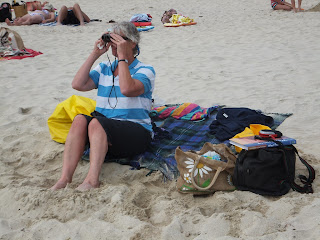A troop of Meerkats are in many ways like a troop of people, always busy and always on the lookout and some people are always involved, doing something, on a mission, checking the horizon, things to do, people to see, having endless energy and so on - well we have nicknamed Carla as THE MEERKAT LEADER and I'm sure she has a large Duracell implanted somewhere to maintain the necessary energy levels.
You know in the Terminator films the indestructible cyborg rides along on his Harley scanning from side to side picking up on any information, clue or threat - well that is what Meerkats do. They scan left and right to pick up early warning of stuff on the horizon.
Meerkat troop on the move
When we arrive at places and tie up there is less than a nanosecond before the Meerkat troop leader's instinct takes over. A visit to the capitainery provides a photographic memory of the BUS TIMETABLE, a copy of the town map and the location of every tourist information office in the county. There is no time for complacency, the time is nigh to make a round trip to wherever looks interesting, to sound out the restaurants, find the best beach, buy the French bread, top up the internet sim card and translate for all the English Yachties who are completely incompetent at communicating with the natives.
I'm not 100% sure if it's true because it all happens before daybreak but I think a typical morning routine for a Meerkat troop leader is as follows:
Rise
S**t Shave and Cut a Cabbage
Swim the channel
Ride the tour de France
Bake bread
Polish the boat windows and wash out the cockpit
Change the engine oil
Scale the mast to check the VHF aerial
While up there scan the horizon for boats arriving and boats leaving
Brew ale for rehydrating various troop members
Catch mackerel for dinner and act as bread fairy, delivering baguettes and croissants to the sleeping masses.
And that is all done whilst listening to the today programme on Radio Wrinkly.
Once the plan for the day has been formulated the schedule starts and the troop follows its leader along in her wake, which is all to the good because we'd probably only see a quarter of everything if she wasn't there getting us all motivated and leading the way.
The only thing that seems to be able to divert a Meerkat from its' planned course is a POSTCARD shop. We'll be all striding along to see the next view, castle, lighthouse or museum when suddenly the lead Meerkat will disappear off sideways from the planned course into a tabac and emerge with numerous postcards - then the hunt is on for stamps and a post box. Once this need has been satisfied the troop will be re-directed back to its' original objective.
One cultural aspect of Meerkat life is the importance of sport. The preferred sport of the adult Meerkat is the sport of POOSTICKS. We've seen this played in the past at Tilford in Surrey but here in Quimper it is a new concept and the French can't quite comprehend the rules. The idea that you drop a stick into a flowing river and time its transit down stream to the other side of the bridge seemed just too exciting for them and it resulted in the number of spectators being quite limited.
The Start is all important
The finish is electofying
The only thing that appears to disrupt or dent the determination of the Troop leader is when the Wi-Fi won't work. When you key in your password and the little tombstones say you're connected but then the internet can't be browsed, the Meerkat goes into a state of decline. The ever optimistic upright stance begins to sag and such expletives as BOTHER and OH DEAR are heard to utter from her direction. It's worse when my old steam laptop connects first time but her new FLAT BRAIN can't be made to work at all.
But credit where credit is due, the Meerkat isn't down for long, she just diverts onto the next objective and we find ourselves following the wake again.
Carla
Not like her mother at all !!























